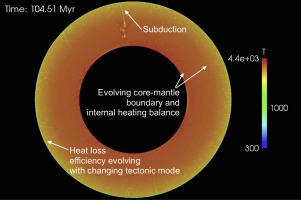当前位置:
X-MOL 学术
›
Planet. Space Sci.
›
论文详情
Our official English website, www.x-mol.net, welcomes your
feedback! (Note: you will need to create a separate account there.)
Planetary thermal evolution models with tectonic transitions
Planetary and Space Science ( IF 1.8 ) Pub Date : 2020-11-01 , DOI: 10.1016/j.pss.2020.105059 Craig O’Neill
Planetary and Space Science ( IF 1.8 ) Pub Date : 2020-11-01 , DOI: 10.1016/j.pss.2020.105059 Craig O’Neill

|
Abstract Thermal history calculations provide important insights into the interior evolution of planets, but incorporate simplified dynamics from the systems they represent. Planetary interiors typical incorporate complex rheologies, viscous layering, lateral heterogeneities, and time delays in processes, which have not been traditionally represented by parameterised approaches. Here we develop numerical models for planetary evolution, incorporating the physical complexity of Earth’s interior, and use them to generate statistically-based Nu-Ra scalings. These encapsulate the main effects of tectonic transitions, geometry, and depth-dependent rheology, and time-sensitivity. We find an exponent β of ~0.26 best describes the Nu-Ra relationship for evolving mobile lid systems, and β ~0.12 for stagnant-lid systems. Systems with time dependent subduction have β varying between ~0.26 during the Hadean, when external factors such as impacts facilitate tectonics, to ~0.12 during the Archaean, when the system is dominated by long periods of quiescence, and systems driven by external forcings (eg. due to impacts in the first 100Myr of Earth’s history) may exhibit much higher exponents. We also find a time-lag between Ra (which primarily depends on mantle temperature) and Nu (normalised surface heat flow) of around 200–300Myr, suggesting a significant delay between mantle thermal configuration, and its surface manifestation. These results provide an approach for the rapid characterisation of tectonic, volcanic, and atmospheric evolution of terrestrial exoplanets.
中文翻译:

具有构造转变的行星热演化模型
摘要 热历史计算提供了对行星内部演化的重要见解,但结合了它们所代表系统的简化动力学。行星内部通常包含复杂的流变学、粘性分层、横向异质性和过程中的时间延迟,这些在传统上没有用参数化方法表示。在这里,我们开发了行星演化的数值模型,结合了地球内部的物理复杂性,并使用它们来生成基于统计的 Nu-Ra 标度。这些概括了构造转变、几何形状和深度相关流变学以及时间敏感性的主要影响。我们发现~0.26 的指数 β 最好地描述了不断发展的移动盖系统的 Nu-Ra 关系,而 β ~0.12 则用于停滞盖系统。具有时间依赖性俯冲的系统的 β 值在冥古宙期间的 ~0.26 之间变化,当外部因素如撞击促进构造时,太古宙期间的 β 变化为 ~0.12,当系统由长期静止主导时,以及由外部强迫驱动的系统(例如. 由于在地球历史的前 100Myr 中的影响)可能会表现出更高的指数。我们还发现 Ra(主要取决于地幔温度)和 Nu(归一化表面热流)之间的时滞约为 200-300Myr,表明地幔热配置与其表面表现之间存在显着延迟。这些结果为快速表征类地系外行星的构造、火山和大气演化提供了一种方法。当外部因素(如撞击)促进构造时,在太古宙期间为 ~0.12,当系统以长期静止为主,并且由外部强迫驱动的系统(例如,由于地球历史前 100Myr 中的撞击)可能会表现出很多更高的指数。我们还发现 Ra(主要取决于地幔温度)和 Nu(归一化表面热流)之间的时滞约为 200-300Myr,表明地幔热配置与其表面表现之间存在显着延迟。这些结果为快速表征类地系外行星的构造、火山和大气演化提供了一种方法。当外部因素(如撞击)促进构造时,在太古宙期间为 ~0.12,当系统以长期静止为主,并且由外部强迫驱动的系统(例如,由于地球历史前 100Myr 中的撞击)可能会表现出很多更高的指数。我们还发现 Ra(主要取决于地幔温度)和 Nu(归一化表面热流)之间的时滞约为 200-300Myr,表明地幔热配置与其表面表现之间存在显着延迟。这些结果为快速表征类地系外行星的构造、火山和大气演化提供了一种方法。由于地球历史上前 100Myr 的影响)可能表现出更高的指数。我们还发现 Ra(主要取决于地幔温度)和 Nu(归一化表面热流)之间的时滞约为 200-300Myr,表明地幔热配置与其表面表现之间存在显着延迟。这些结果为快速表征类地系外行星的构造、火山和大气演化提供了一种方法。由于地球历史上前 100Myr 的影响)可能表现出更高的指数。我们还发现 Ra(主要取决于地幔温度)和 Nu(归一化表面热流)之间的时滞约为 200-300Myr,表明地幔热配置与其表面表现之间存在显着延迟。这些结果为快速表征类地系外行星的构造、火山和大气演化提供了一种方法。
更新日期:2020-11-01
中文翻译:

具有构造转变的行星热演化模型
摘要 热历史计算提供了对行星内部演化的重要见解,但结合了它们所代表系统的简化动力学。行星内部通常包含复杂的流变学、粘性分层、横向异质性和过程中的时间延迟,这些在传统上没有用参数化方法表示。在这里,我们开发了行星演化的数值模型,结合了地球内部的物理复杂性,并使用它们来生成基于统计的 Nu-Ra 标度。这些概括了构造转变、几何形状和深度相关流变学以及时间敏感性的主要影响。我们发现~0.26 的指数 β 最好地描述了不断发展的移动盖系统的 Nu-Ra 关系,而 β ~0.12 则用于停滞盖系统。具有时间依赖性俯冲的系统的 β 值在冥古宙期间的 ~0.26 之间变化,当外部因素如撞击促进构造时,太古宙期间的 β 变化为 ~0.12,当系统由长期静止主导时,以及由外部强迫驱动的系统(例如. 由于在地球历史的前 100Myr 中的影响)可能会表现出更高的指数。我们还发现 Ra(主要取决于地幔温度)和 Nu(归一化表面热流)之间的时滞约为 200-300Myr,表明地幔热配置与其表面表现之间存在显着延迟。这些结果为快速表征类地系外行星的构造、火山和大气演化提供了一种方法。当外部因素(如撞击)促进构造时,在太古宙期间为 ~0.12,当系统以长期静止为主,并且由外部强迫驱动的系统(例如,由于地球历史前 100Myr 中的撞击)可能会表现出很多更高的指数。我们还发现 Ra(主要取决于地幔温度)和 Nu(归一化表面热流)之间的时滞约为 200-300Myr,表明地幔热配置与其表面表现之间存在显着延迟。这些结果为快速表征类地系外行星的构造、火山和大气演化提供了一种方法。当外部因素(如撞击)促进构造时,在太古宙期间为 ~0.12,当系统以长期静止为主,并且由外部强迫驱动的系统(例如,由于地球历史前 100Myr 中的撞击)可能会表现出很多更高的指数。我们还发现 Ra(主要取决于地幔温度)和 Nu(归一化表面热流)之间的时滞约为 200-300Myr,表明地幔热配置与其表面表现之间存在显着延迟。这些结果为快速表征类地系外行星的构造、火山和大气演化提供了一种方法。由于地球历史上前 100Myr 的影响)可能表现出更高的指数。我们还发现 Ra(主要取决于地幔温度)和 Nu(归一化表面热流)之间的时滞约为 200-300Myr,表明地幔热配置与其表面表现之间存在显着延迟。这些结果为快速表征类地系外行星的构造、火山和大气演化提供了一种方法。由于地球历史上前 100Myr 的影响)可能表现出更高的指数。我们还发现 Ra(主要取决于地幔温度)和 Nu(归一化表面热流)之间的时滞约为 200-300Myr,表明地幔热配置与其表面表现之间存在显着延迟。这些结果为快速表征类地系外行星的构造、火山和大气演化提供了一种方法。











































 京公网安备 11010802027423号
京公网安备 11010802027423号